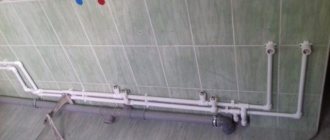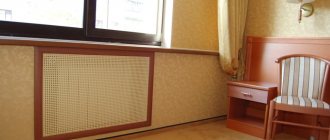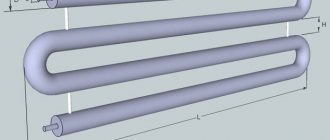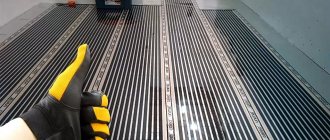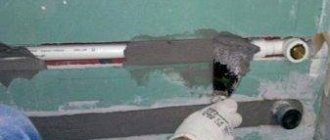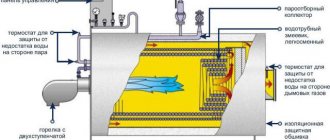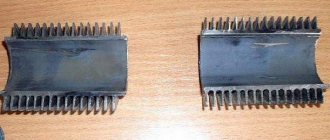Heating appliances operate continuously during the cold season, distributing heat throughout the apartment. Since Soviet times, radiators have been used to heat rooms and for more prosaic needs: they were used to dry clothes and clothes.
Clothes dryer with battery
A home-made clothes dryer on a radiator is compact and can be easily removed if necessary. The lightweight design successfully replaces bulky balcony counterparts, where drying things in winter is difficult and time-consuming. Near the radiator, laundry will dry faster and will not take up much space, as is the case with large floor drying structures.
Battery-powered clothes and shoe dryers, what types are they?
There is no point in jumping into work without seeing alternative options. Let's evaluate them together.
It is easy to make a hanging dryer from thick wire. Of course, it will have to be painted several times so that the linen does not get dirty. Additionally, you can put a PVC tube on the wire. The basis of the design is two hooks and a shelf of several lines of wire. In the absence of welding, the joints can be fixed with thin copper wire and wrapped with white electrical tape.
If we are talking only about drying shoes, you can make special hooks for each shoe. Their number is determined by the length of the radiator.
Nothing prevents you from making a structure from wood. It is convenient to screw self-tapping screws into the wood, which secure the required number of rows of ropes.
The dryer is very simple: two hooks made of slats are connected to each other by a crossbar. The frame with ropes is held on hangers. In my opinion, the structure should be strengthened with an inclined stop between the horizontal bar on the hooks and the far edge of the frame.
This original dryer is made of two boards and transverse tubes. The items mentioned can be purchased at a building materials store. Pipe plugs are easy to pick up at a furniture hardware store.
Homemade dryers made from polypropylene pipes are popular. They are suitable for drying clothes and shoes.
If the issue of drying clothes is urgent, a large spatial dryer is possible, through which hot water circulates. The structure is connected via flexible hoses through two taps. For the summer it can be detached and put away.
Video
The video will tell you how to make a collapsible fish dryer, which you will need when fishing:
About the author: Egor Taranenko
Electronic engineer with many years of experience. For several years he was involved in organizing the repair of household appliances, including washing machines. Loves sport fishing, water tourism and travel.
Found a mistake? Select it and click the buttons:
Ctrl + Enter
Interesting! History knows the fact that a kitten fell into the drum of a washing machine and, after going through a full wash cycle on the “Wool” program, got out of the unit unharmed. The only trouble for the pet was an allergy to washing powder.
Washing machines have something to do with the origin of the expression “money laundering.” In the 1930s, American gangsters used a network of laundries as a cover for their illegal activities. By passing off the proceeds of crime as proceeds from cleaning clothes, they turned “dirty” money into “clean” money.
There are a variety of balls that are used in the washing machine. Antistatic ones will prevent the fabric from sticking to the body after washing, balls with special loops will “comb” the lint and prevent the appearance of pills, and silicone ones with pimples will prevent fluff from matting when washing outerwear.
The expression “soap opera” (“soap”) did not arise by chance. The very first series and shows that had a female audience were broadcast on television at a time when housewives did cleaning, ironing and laundry. In addition, to attract female viewers to the screens, commercials for detergents: soaps and powders were often played on air.
The first officially patented washing machine was made of wood and was a box with a frame, half filled with wooden balls. Laundry for washing and detergent were loaded inside and the frame was moved using a lever, which, in turn, made the balls move and grind the laundry.
For washing small items on the road or in a hotel, it is convenient to use a regular plastic bag. Socks or tights are kneaded inside a tied bag along with water and a small amount of detergent. This method allows you to pre-soak things and wash them without damaging the fabric or wasting a lot of powder and water.
In the 19th century, washing ladies' toilets took a lot of time. The dresses were first ripped open, and then each part was washed and dried separately so that the fabric did not become deformed. After washing, the clothes were sewn again.
Astronauts, while in Earth orbit, solve the problem of dirty things using an original method. Clothes are dropped from the spacecraft and burn up in the upper atmosphere.
There is a washing machine “for bachelors”. Linen washed in such a unit does not need to be ironed at all! The thing is that the device does not have a drum: some things can be placed inside the container directly on hangers (for example, jackets and shirts), and smaller things (for example, underwear and socks) can be placed on special shelves.
Making a hanging dryer for a heating radiator with your own hands
Let's consider making a popular version of a dryer made of plastic pipes with three lines for clothes. We will need the following materials and tools:
- polypropylene pipe with a diameter of 20 mm and a length of about 3.5 m;
- tees of the appropriate size 4 pcs;
- corners of the same diameter 4 pcs;
- plugs of the appropriate size 4 pcs;
- a special soldering iron for pipes or glue for plastic;
- scissors for cutting plastic pipes or a hacksaw for metal.
First, let's cut off the pipes necessary to assemble the structure. It is convenient to use a special pipe cutter, but this operation can also be performed with a regular hacksaw for metal.
You can adjust the dimensions of the parts based on specific conditions. For this example we will need:
- 4 segments 6 cm long between the lines for placing linen;
- 2 pieces 11 cm long to form hooks;
- 2 pieces 25 cm long for vertical hook elements;
- 3 pieces 80 cm long as lines for placing laundry.
As a result, we receive a complete set of parts necessary to assemble the structure.
If you have a soldering iron for joining heating and water pipes, the dryer can be assembled using it. If you don't have a special tool, you can use glue. For details on how this is done, read the article “How to glue polypropylene and polyethylene, including foam, what glue is used to glue it to concrete or metal?”
What was used
The set of PP fittings includes:
- pipe 3/4 – 3 m;
- angle 90 deg. 3/4 – 6 pcs.;
- coupling with external thread (MRN) 3/4 - 2 pcs;
- tap with internal thread and American (BB) 3/4 – 3 pcs.
- adapter (VN) 1/2-3/4 – 2 pcs.;
- clamp with 3/4 fastening – 3 pcs.
- a little tow.
Important. To guarantee the stability and safety of the system, a pipe for the central heating system was used, costing $2 per linear meter. Inside it there is a layer of aluminum visible on the cut.
Metallized pipe
Another option from polypropylene pipes
Of course, the dimensions of the dryer may be different, and the number of lines for laundry can be increased. In this case, it turns out to save some material, and the principle of installation on the battery will be different. The fact is that the window sill sometimes hangs over the heating radiator and does not allow inserting a dryer from above.
In this case, you should make a frame from plastic pipes, as indicated above. As a clothes hanger, you can use a cord or stainless steel wire, which is threaded through the holes in the pipes. Do not pull the ropes too tightly, as the frame may bend.
For fastening to the battery, two M 8 bolts about 120 mm long, complete with nuts and washers, are used. They are fixed in holes on the long side of the frame at a distance corresponding to the size between the gaps in the radiator. To prevent the bolts from scratching the battery, they are covered with heat shrink tubing and exposed to heat. You can install the dryer in place and use it!
Frame
You will need 4 pipe pieces and 4 angles. The frame is attached to the wall with hooks or hinges, in the bathroom or on the balcony. Stretch ropes across the frame - you can simply tie them. Or make a series of holes in the pipes and secure the ends of the rope in them.
The frame hangs on the wall. To dry clothes, it must be raised to a horizontal position. Support the free end with a stand, tie it to the ceiling or wall - as convenient for the hostess.
You can make any number of cross members in the frame using tees. It is more convenient to hang things on them than on ropes.
Reading reviews
A considerable number of people have already tried in practice both purchased and home-made designs of battery-powered clothes and shoe dryers. Excluding unnecessary elements of speech, we present only useful reviews and statements:
- “the likelihood of scratching the battery or tearing thin fabric, for example, nylon socks, is virtually zero”;
- “easy to use, can be removed during storage”;
- “Laundry dries quickly on it; although the structure itself heats up, it does not emit any odors, although it consists of plastic tubes.”
In other words, the time spent on assembling crafts for the home will not be wasted. I wish everyone good luck and offer a video on the topic in addition.
Battery dryer made of plastic pipes in bookmarks 2
Such a dryer will be useful in absolutely every home, especially for those who have small children. Since they need to constantly dry diapers and undershirts. The dryer is made in 15-20 minutes from polypropylene pipes. This is not a stand-alone design; it is designed to be attached to an existing heating battery. But there is a plus here that, if desired, you can hang the dryer on all radiators and dry clothes or shoes on them. It looks very aesthetically pleasing:
For manufacturing you will need pipes 20-25 mm in diameter.
Tees and 90 degree angles.
First you need to measure the battery. And decide how the dryer will be attached to it, since all batteries are different, and you may have to make the design differently.
We begin soldering with a soldering iron for polypropylene pipes. You can do without such a soldering iron by using a portable gas burner.
We ended up with two sides of the dryer. Now they can be tried on the battery to determine the size of the longitudinal pipes.
Now we solder the middle pipes.
Finished dryer with three poles.
Before this I made an earlier model with two bars.
Installation of a simple dryer on a heating radiator
This homemade product is simple and suitable for those who want to try their hand at assembling products from polypropylene tubular material.
The table provides step-by-step assembly instructions:
For assembly you will need four pieces of plastic tube with a diameter of 25 mm, four corners suitable for the selected diameter (25 mm), two M8 bolts (110 mm long), as well as two nuts for the same thread (M8). In addition, it is advisable to have two washers and a heat-shrink tube for the bolts so as not to scratch the radiator (not shown in the photo)
Using a pipe cutter, cut two pieces of tubular material 60 cm long and two pieces 70 cm long. To fit the angle tightly onto the pipe, use a PVC pipe soldering iron. The angle and pipe are heated by the device, then removed from the metal heaters and immediately connected to each other. This ensures a tight connection
The result should be a rectangular outline
In one of the 70 cm long tubes, drill two holes with a diameter of 8.5 mm. If you want the structure to stay on the radiator more firmly, you can drill three holes. Insert the bolts into them so that the heads are inside the outline
Place washers on the threaded side of the bolts and tighten the nuts. Then put on the heat shrink tubing (if you have one) and heat it with a hairdryer until it fits tightly around the bolts
In both tubes, which are shorter (60 cm), drill 5 holes with a diameter of 3-4 mm
Pull a laundry cord through the holes in the tubes, as shown in the photo. To keep it well, tie a double knot on one side. Once the cord is fully stretched, secure it with the same knot at the other end. This completes the process of making a simple clothes dryer
After watching this video, readers will be able to familiarize themselves in detail with the process of making a clothes dryer:
Floor structures
Sliding floor clothes dryers are a wonderful mobile design for arrangement in any room of the apartment, while when folded they do not take up much space and can be easily stored in the pantry. These dryers are quite simple to disassemble, but they vary in parameters and layout.
Among the advantages are mobility, ease of installation, variety of product range, compactness, and the ability to install dryers, as in the photo, in the bathroom and other rooms. However, fairly large structures can be heavy, but for ease of movement they are equipped with wheels.
Having once taken up the task of modernizing floor-mounted clothes dryers, designers came up with many original options that even looked like innovative installations.
Battery-powered clothes dryer without cord
We offer our readers another option for making a dryer, this time without a clothes cord and with a different, more reliable method of attaching it to the radiator. This device will help out in situations where you need to quickly dry baby clothes.
Such a dryer can have any number of crossbars (of course, within reason, since the mount will not support much weight). The manufacturing process is described in detail below:
For assembly you will need several pieces of plastic pipes with a diameter of 20 mm, a length no less than the width of the heating radiator. Their number depends on how many crossbars there will be in the product. You will also need four rectangular corners and fittings in quantities that also depend on the number of cross members. Two require 2 fittings, three require 4, etc.
To make a dryer with three crossbars, another pipe will be used to make four small pieces of pipe of the same length and four longer ones. The length of the latter will depend on the depth of the radiator and it must be calculated so that the near crossbar of the dryer is located behind the plane of the heating radiator
Important options to select
Making delicious and healthy marshmallows
For an electric dryer to become a truly good helper during the harvest season, it must be:
This will be influenced by the number and volume of pallets or surface area. Options for dryers up to 5 trays are a good choice for a small family. They are capable of drying several kilograms of food at a time. For more serious harvests, devices with 6 or more tiers are purchased. Models with 15-20 sections are capable of drying up to 15 kg of fresh food.
Allows you to dry various fruits and vegetables
Directly depends on the capacity of the device. A good option are 350-600 W models, which have sufficient capacity, efficiency, and do not consume a huge amount of energy.
You can set the desired temperature
Makes it possible to preserve all the beneficial properties and vitamins in products. Many convective devices are available with fixed 3 modes:
- 30-40С (Low) – light load
- 45-55С (Medium) – average load
- 60-75C (High) – high load
The last 2 modes are relevant for preparations from vegetables, fruits, berries, mushrooms, meat, and fish.
Plastic dryer for vegetables and fruits
Available in 2 main versions:
- metal – strong, reliable, durable; has significant weight; may get warm during operation
- plastic – light in weight, easy to clean
Plastic models are easy to assemble and disassemble, make it possible to increase the number of tiers, and are also transparent, which is convenient for monitoring the drying process.
With mechanical control
- the electronic view is equipped with a touch screen and keys for convenience; less exposed to pollution; adjustment is more precise
- mechanical appearance is reliable
Horizontal arrangement of trays is a more convenient option
- Trays are located vertically (one above the other) in many convective type electric dryers. Heating can be from above or below. The first option is more durable and easier to maintain, because... nothing gets on the heating block. Although devices with bottom heating cope well with large volumes of products
- horizontal arrangement of pallets is more convenient. Trays can be easily removed without affecting others. The heating block is located on the rear wall. It is also possible to simulate the chamber space by removing the pallets altogether. This way you can place large items, such as yogurt jars.
It is possible to make pastille
- the ability to prepare marshmallows or dry-dry meat and fish
- Thanks to the system of independent supply of hot air to each of the pallets, there is no need to swap them during drying
- There is no risk of getting over-dried food if the device has an auto-shut-off timer
- a device with overheating protection will be safer and last longer
- the adjustable height of the trays is useful, for example, for mushrooms, in order to dry them without chopping them
Good quality sofas: how to choose a universal model for relaxing and sleeping. Popular manufacturers + Reviews

